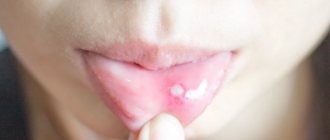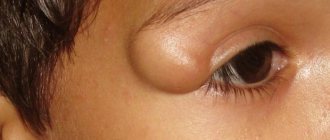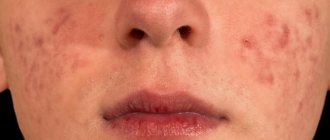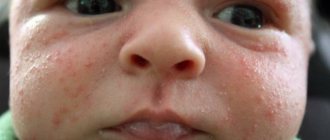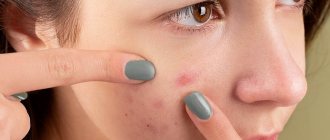Allergic rash in a newborn
An allergy in an infant is an unfavorable immune response of the child’s body to a potentially dangerous substance. Most often, an allergic rash occurs when a nursing mother consumes foods that can act as an irritant. This group includes:
- cow's milk;
- soy [1] and egg white;
- fish;
- strawberry;
- nuts.
The first sign of a developing allergic rash is peeling. Pathological lesions with dry skin on the face of a newborn form symmetrically and are localized on the cheeks and forehead. It is necessary to consult a doctor if the appearance of rashes affects the general condition of the baby. Irritability, restless sleep, gastrointestinal disorders, fever and vomiting are dangerous symptoms that should be stopped immediately under the supervision of a pediatrician.
Why do children get acne?
There are a huge number of reasons why acne appears on a child’s face. They may be related to the following processes:
- Allergic reaction.
- Intestinal dysbiosis.
- The baby will overheat.
- Viral disease.
- Improper hygiene.
- Hormonal imbalance.
- Increased sebaceousness of the skin glands.
Each of these reasons deserves a mandatory consultation with a doctor. This is the only way to prevent further rashes and alleviate the baby’s condition.
Newborn acne
Neonatal acne can appear in the first weeks of a baby's life on the forehead, nose and cheeks. In appearance, they resemble pimples with purulent heads, characteristic of teenage rashes. It is assumed that the cause of acne is increased production of sebum , which clogs the ducts of the sebaceous glands and provokes an inflammatory reaction. The pathogenesis of the appearance of small pimples in newborns is also associated with the formation of the hormonal system. The body gets rid of the transplacental influence of maternal androgens [2], and adrenal hormones begin to be produced more intensively, which affect the condition of the skin. Newborn acne does not require treatment [9] - standard daily care using delicate soap or baby cosmetics is sufficient. In most cases, pimples that appear on the face go away on their own by the age of 4 months.
Non-infectious acne in children of different ages
Regardless of age, doctors distinguish between infectious and non-infectious types of acne. The first category includes the following rashes:
- Prickly heat.
- Hormonal acne.
- White dots.
- Allergic reaction.
- Pustules.
In most cases, acne on a child’s face does not indicate serious health problems. The most harmless rashes on this list include white pimples and hormonal acne. Other types of non-infectious rashes should be checked by a doctor to determine further treatment.
Prickly heat
Miliaria is a skin lesion that is associated with hyperfunction of the sweat glands and irritation of the excretory ducts . The disease can develop as a result of improper care of the newborn’s skin, prolonged stay in hot rooms and the wrong choice of clothing (the child is wrapped tightly). Miliaria resembles an allergic rash, but differs from it in localization. Signs of an allergy most often appear on the skin of a child’s face, and with prickly heat, rashes form throughout the body - most often in natural folds, on the neck, lower abdomen and upper chest. What does prickly heat look like:
- small blisters with transparent contents, prone to burning and itching;
- in difficult cases – reddish nodules with an inflamed rim;
- with extensive skin damage - weeping areas.
Miliaria itself is not dangerous to a child’s health. But damage to the skin is fraught with the addition of a bacterial or fungal infection. In this case, purulent processes develop, the skin becomes swollen, and a putrid odor appears. Red pimples associated with heat rash cause discomfort in the child - he becomes capricious and irritable, refuses to eat and sleeps poorly.
How to treat infectious acne on the face
When a child suffers from a viral disease, acne may appear on his face, which is considered one of the signs of a particular illness. Some diseases show their first symptoms in the form of rashes on the face. In this case, parents should go to the hospital in time and diagnose the infection in the baby’s body.
Next, doctors take care of his appropriate treatment. Therapy is most often carried out using antibiotics and other serious drugs. Acne on a child's face always goes away along with the infection during the recovery period. Therefore, it makes no sense to treat them separately, because they are only a consequence of the disease. However, during the treatment period it is necessary to ensure that the child adheres to the following recommendations:
- Pimples should not be squeezed, scratched or picked off. Otherwise, after recovery, scars will remain on your face and body.
- In order not to damage the wounds, you need to put special soft mittens on your child’s hands every night, which will prevent pimples from being ripped off the face.
- Treat rashes with a bactericidal solution every day.
If you follow these rules, your child’s recovery will be much easier.
Seborrheic dermatitis
Not only red pimples, but also yellowish scales may appear on the skin of a newborn. These are signs of seborrheic dermatitis, a disease associated with increased secretion of sebum. Scales form in the first month of life on areas of the body with a large accumulation of sebaceous glands - on the scalp, upper third of the back, face, chest and in the ear area. Seborrheic dermatitis is sometimes called “milky crusts”, which may be associated with the use of inappropriate cosmetics for the care of infant skin. In fact, the disease is caused by high levels of maternal hormones in the blood or changes in the biochemical composition of lipids on the surface of the skin [4].
In most cases, childhood seborrheic dermatitis goes away on its own. Parents just to take care of proper care , but it is not recommended to diligently remove the crusts - you risk damaging the delicate skin and causing infection. It is better to use specially developed products - such as Foam Shampoo for “milk crusts” for newborns. It facilitates the removal of scales in 90% of cases , and in 95% of babies it soothes the scalp [5.2]. The product contains 99% ingredients of natural origin. The shampoo is fragrance-free and has a “tear-free” formula. If you have thick, dense scales, which are located not only on the scalp, but also in other areas, a “milk crust” cream , which helps to completely remove “milk crusts” in an average of 7 days [5.3].
Treatment of acne in babies
Depending on the type of acne, your doctor may prescribe the following treatment methods:
- Bepanten cream or powder from the same company. This is how diaper rash and prickly heat are treated.
- Baths with the addition of herbal infusions: sage, calendula, chamomile, string herbs, etc. With the help of medicinal herbs, you can remove white pimples on a child’s face, as well as remove all redness.
- For allergic rashes, a nursing mother is prescribed a strict diet. If your baby is fed artificial formula, it is necessary to reconsider his diet.
- Acne on a child’s body can be wiped with Furacilin.
- Some rashes will need to be treated with antihistamines.
- If you have chickenpox, you will be prescribed to treat the skin with regular brilliant green.
Atopic dermatitis
Atopic dermatitis is a disease of an allergic nature, which is accompanied by chronic inflammation of the skin. The causes of an uncontrolled allergic reaction in infants are:
- food allergens – animal protein, soy products, some types of vegetables;
- airborne allergens - household dust, pollen, pet hair, tobacco smoke, etc.;
- pathogenic microflora - fungi, viruses, bacteria.
In newborns, the erythematous-squamous form of atopic dermatitis with signs of an acute inflammatory reaction is most often diagnosed:
- skin hyperemia;
- peeling;
- flat small papules.
Red spots are localized on the arms and legs in the folds , on the sides of the neck, on the back of the hands and on the cheeks. Children with atopic dermatitis are advised to regularly cleanse and moisturize their skin [6]. Anti-inflammatory drugs are prescribed only for extensive skin lesions that impair the baby's quality of life - in this case, you should consult a pediatrician.
For daily care, it is recommended to use STELATOPIA emollient cream . Research [5.1] has shown that emollient:
- In 90% of cases, it reduces increased dry skin [5.1] and reduces the likelihood of clinical signs of AD by 51% [10]
- Relieves itching sensation in 91% of cases [5.1]
- Reduces inflammation after 32 hours[11]
Preventing rashes in babies
To prevent the development of rashes, it is necessary to promptly determine the causes of acne on a child’s face, provide good skin care, and also not neglect visiting doctors. Any self-medication can harm the baby’s health. Regardless of the type of rash, the body is first diagnosed. Only after a comprehensive examination can you carry out the treatment and prevention measures prescribed by your doctor. If acne appears on the face and body, consultation is given by an immunologist and an allergist.
Prevention of rashes depends on the age of the child. To prevent the appearance of acne in babies, it is necessary to control the temperature in the place where it is located, carry out bathing procedures only with organic cosmetics, and the mother will have to strictly monitor the feeding of the baby. When breastfeeding, you need to eat a strict diet, and when feeding artificial formulas, give preference to the most famous manufacturers.
Red large pimples on the butt and body of the child
There are many different reasons for the formation of large red pimples on the bottom and body of a child.
Depending on age, the following reasons are distinguished:
- Hormonal changes in the child's body. As a rule, the resulting acne goes away over time without the use of medications.
- Allergic manifestations. Often found in children when the mother’s diet is violated. Rashes can also be caused by hygiene products or the quality of clothing, food, dust, or the presence of pets. Such pimples are accompanied by itching and are very dangerous in terms of possible impact on the child’s health.
- Using low-quality diapers or using them for a long time.
- Hypothermia. Accompanied by abundant formation of red pimples on the child’s body, usually between the ages of two and seven years.
- Prickly heat. In children, very often, acne forms precisely for this reason.
- Infectious diseases. If there is a virus in the body (measles, chicken pox, herpes, rubella), painful, watery pimples may appear on the bottom and then spread throughout the child’s body. Large purulent pimples in a child also form under the influence of infection. Purulent formations (white or yellow) occur due to skin damage by staphylococcal bacteria. Pimples caused by infection should not be squeezed, as this can lead to the formation of eczema. Most often, children become infected with these infections in kindergartens and schools.
- Nervous overstrain. In school-age children, stress conditions contribute to the formation of acne. They can be caused by adaptation to school, worries about the educational process and many other factors.
- Vaccination. Children's bodies can react specifically to vaccination, including the formation of pimples on the butt and body.
- Various insect bites. The appearance of acne for this reason poses a great threat to the body. Bites can lead to allergic processes or viral damage to the body.
- Diabetes. Due to the increased sugar content in the urine, red acne may form on the baby's bottom.
How to treat purulent acne in men? More details here.
Traditional therapy
Creams help slow down the functioning of the sebaceous glands. But many products contain antibiotics, so traditional methods of treatment are often used. Their main advantage is simplicity and accessibility, as well as efficiency.
Among them are:
- egg white mask: you need to separate the yolks from the whites of a raw chicken egg. The whites are whipped until a thick consistency is obtained and applied to the skin of the face. Wash off the mask after twenty minutes. The remaining yolks are used to spread on the child’s acne before bedtime;
- baking soda solution: a handful of baking soda is moistened with water and applied to the face. After twenty minutes, you need to wash your face with warm water;
- boiled potato mask: helps remove large white pimples. Crushed potatoes are mixed with a teaspoon of honey, two tablespoons of cream and a raw yolk from a chicken egg. Leave the mask on for fifteen minutes and rinse off;
- fruit masks: one of these contains orange and cherry pulp with the addition of flour. You will need two tablespoons of orange pulp and flour and four tablespoons of cherry pulp. Twenty minutes after application, you need to wash your face with warm water;
- calendula tincture: juice and calendula flowers, in the amount of two tablespoons, pour seventy milliliters of alcohol and fifty milliliters of water. Treat acne twice a day;
- yeast mask: place ten grams of yeast in fifty grams of boiled water and add five drops of lemon juice. Apply the mask to your face for twenty minutes and then rinse off.
Should acne on a child’s body be left without proper attention, in the hope that it will go away on its own, or should we begin immediate treatment? This question certainly arises from time to time in every mother. The fact is that the immune system of a small organism is not yet sufficiently developed to resist various infections. Namely, acne is very often a characteristic symptom of infectious diseases.
Prevention
To prevent colds, it is recommended to adhere to the following rules:
- avoid drafts, prevent hypothermia and increased sweating;
- When performing physical activity accompanied by sweating, immediately after finishing it, take a warm shower. Sweat contributes to skin irritation, resulting in acne formation;
- using warm baths with sea salt;
- maintaining immunity with the help of various vitamin complexes;
- healthy eating;
- recreational physical education;
- maintaining facial skin hygiene;
- correct and quick treatment of a cold at the first sign.
Treatment
To treat most acne in children under one year of age, you should maintain proper hygiene, use baby powder, change diapers more often (reduce their use if possible), and take air baths.
In the presence of infectious diseases, a course of therapy is prescribed by a doctor. In case of observing an allergic reaction of the body, suprastin is most often used.
Very often, acne on the bottom and body of a child is treated with traditional methods. Such methods give effective results.
It can be:
- bathing the child with the addition of a decoction of herbs (chain, sage, birch buds, chamomile), you can also use decoctions to wipe acne;
- for acne caused by allergies, use a decoction of bay leaves: about ten leaves are placed in a pan, then a liter of water is added and put on low heat. Bring to a boil and cool, the resulting decoction is applied to the affected skin or added to bathing water;
- sea salt: dissolve five tablespoons of sea salt in one liter of warm water. Use to moisten acne or add to bathing water. This method is not recommended for children under two years of age.
